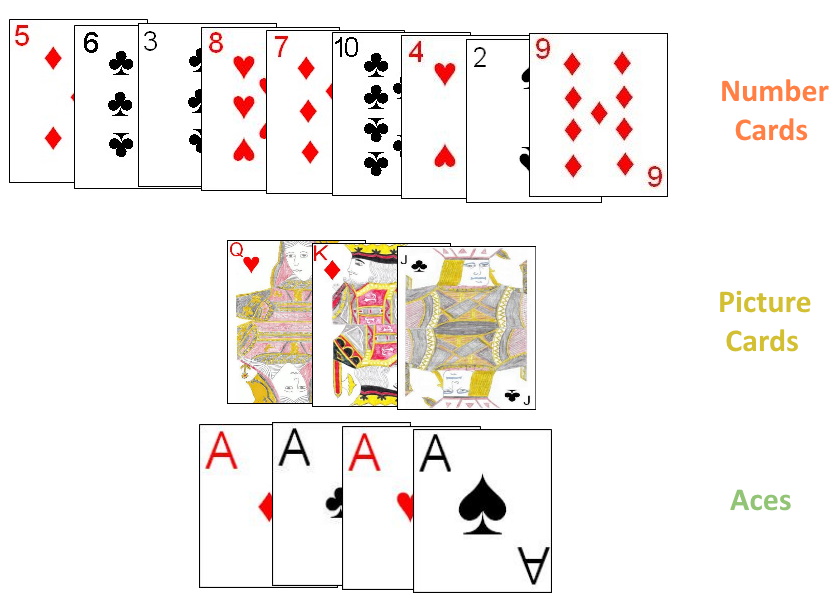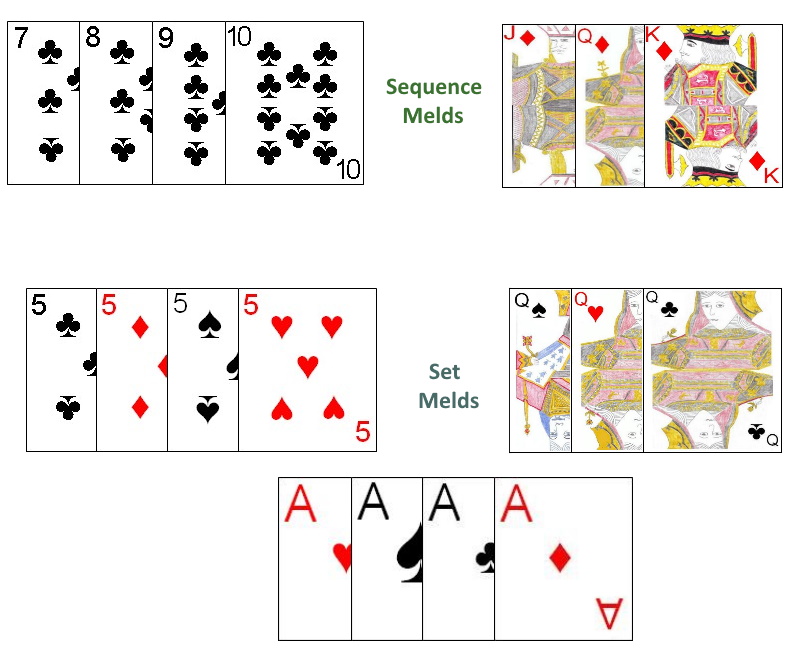How to Play Indonesian Remi
 Indonesian Remi (or just Remi) is a game from the Rummy family which
originated and is most commonly played in Indonesia. However, although the
game offers many similarities to some more commonly known versions of these
melding type games, it also has a number of features which make it uniquely different.
Indonesian Remi (or just Remi) is a game from the Rummy family which
originated and is most commonly played in Indonesia. However, although the
game offers many similarities to some more commonly known versions of these
melding type games, it also has a number of features which make it uniquely different.Indonesian Remi uses one standard 52 card deck. For purposes of melding in this game, the cards in the deck can be thought of as being of one of three distinct types. First there are the number cards, which are all the cards with the numbers from 2 to 10, printed on the face of the card. The sequential ranking of these number cards are as would normally be expected (from high to low); 10, 9, 8, 7, 6, 5, 4, 3, 2. The second type of cards are the Picture cards, which consists of all Kings, Queens and Jacks. The third type of cards are the four Aces in the deck, one of each suit. Any specific individual melded combination must consist of all cards from one type.
Indonesian Remi is designed for play by two, three or four players, each playing independently. Determination of seating positions and first dealer can be performed in a number of methods, including a draw for high cards. Each player would draw from the shuffled deck. If drawing a card other than a number card, they should set that aside and draw a new card, and continuing to draw further cards until drawing a number card. In addition, if multiple players draw cards of the same denomination, those players should discard those cards and draw again. The players then seat themselves at the table in the order of rank of cards drawn, from highest drawn to lowest. The player drawing the highest ranked card can be set as the highest dealer for the first hand. For every hand after the first, the player who currently has the lowest current accumulated score is set as the dealer for the next hand.
Once the players are seated and the dealer determined, the dealer should then thoroughly shuffle the deck and offer it to the player at his right to cut. After the cut, the dealer begins dealing the cards around the table in a clockwise direction starting with the player at his immediate left. The cards are dealt in front of each player face-down and one-by-one. The dealer continues dealing the cards in this way until each player (including himself) has seven total cards. The remainder of the undealt deck is set in a face-down pile in the center of the table as the stock pile. Unlike most other Rummy type games, after the deal in Indonesian Remi, the top card of the stock is not turned over to start the discard pile. The dealer has the first turn in every hand, and the turn to play then continues in a clockwise direction around the table.
As in many Rummy type games, the object of play in Indonesian Remi is to earn points during the hand by melding valid combinations to the table. However, to be a valid meld in this game, there are a few additional restrictions. The two types of valid melds in Indonesian Remi are:

- Sequence: There are two types of Sequence melds in Indonesian Remi. The first type is three or more number cards (cards in the denomination 2 - 10) in direct sequential order, all of the same suit. The second type of Sequence meld in this game is one Jack, one Queen and one King, all of the same suit. Sequence melds of either type may never contain any Aces.
- Set: A set meld in Indonesian Remi is three or four cards, all of the same ranking (such as four fives, three Queens, or four Aces).
Each turn consists of several parts. First the player must draw a card. Normally this would consist of drawing the top card of the face-down draw pile and adding this card into the hand. However in certain events the player may take one or more cards from the face-up discard pile. If the player, at the start of his turn, has two (or more) cards in his hand which can be combined with one of the top three cards on the discard pile, he is entitled (but never required) to take this card into his hand. In addition to taking that card from the discard pile, however, he must also take all cards which are on top of that card in the pile. To do this, the player must first lay down the cards from his hand which will combine as part of the meld and then take the appropriate discard pile cards, adding the card from the discard pile to complete the meld, which remains on the table. Only one card from the cards taken from the discard pile may be used in this meld, however. If the discard pile currently contains no cards, the player must, of course, opt to take the top card from the stock pile. If a player has not yet melded a Sequence meld on a prior turn, he may also not take cards from the discard pile to help in forming a Set meld.
After the draw, a player may optionally make one or more melds if willing and able, to the table.
Finally, to complete his turn, a player discards any one card from his hand to the discard pile. In discarding, the cards should be discarded in such a way that each card below it in the discard pile is partially visible (to allow the players to see the identify of each discarded card in the pile).
The hand continues in this manner until one player can meld every card in his hand, except one, into valid melds. The player must complete his turn with a discard of his last card (called the closing card) to the discard pile. Alternatively, the game can end by exhaustion of the stock pile. If a player on his turn, intends to draw from the stock pile, but there are no more cards in that pile, the hand immediately ends.
Once the hand ends, through either of these events, each player earns a score for the hand, which can include both negative and positive scoring. A player earns a positive point value for each card he has successfully melded during the hand and must subtract a number of points for each card left in his hand (whether it could be formed into a valid meld or not). The point values for the cards are as follows:
| Card | Point Value |
|---|---|
| Number Cards (2, 3, 4, 5, 6, 7, 8, 9, 10) | 5 Points Each |
| Picture Cards (Jack, Queen, King) | 10 Points Each |
| Aces | 15 Points Each |
In addition, for a player who manages to end the hand by playing all his cards, and discarding his last, that player earns a number of bonus points on the hand based on the card used as his last discard. The following chart shows the bonus points earned, dependent on that card discarded:
|
 |